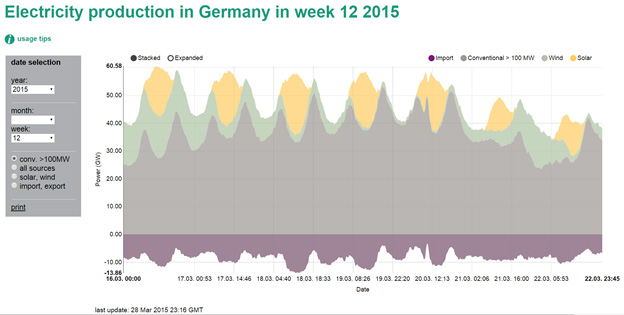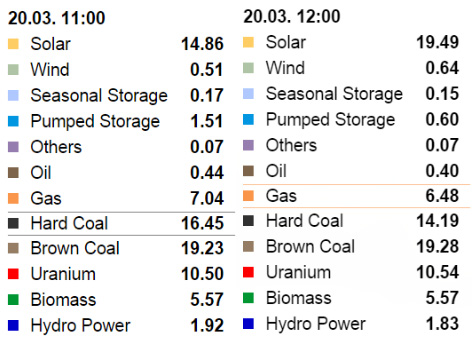What did the solar eclipse prove in Germany?
and lead author of EnergyTransition.de.(@PPchef)
On Friday, March 20, a partial solar eclipse passed over Germany on a largely cloudless day. With the moon covering the sun by more than 70 percent in most areas, German solar ramped down and then up again to an unprecedented extent. Many have celebrated the event as proof that Germany can withstand even greater fluctuations in solar power production. But there is also a reason to believe the event was overhyped.
First, the good news – there was no blackout or any other major disturbance on the German grid. Nonetheless, solar power production ramped fairly close to the maximum. Grid experts had calculated an increase of 17 GW from 9 GW to 26 GW within 90 minutes (from 10:30 AM to 12 noon) in the worst-case scenario of a completely cloudless sky. In the end, we got a ramp from 5.44 to 19.6 GW – so the increase was a full 14 GW, only 3 GW short of the worst case. This much we can celebrate: an unprecedented spike in solar power production – one equivalent to roughly a fifth of power consumption at the time (around 70 GW) – did not bring down the grid.
But how did Germany compensate for these fluctuations? Official figures are not yet in, and live data can be unreliable, but what we do know suggests that the whole event was unremarkable aside from the rapid spike in solar power production. Indeed, the main difference aside from solar may have been the use of demand management, about which we have the least data to date. Let’s start with Fraunhofer ISE’s overview of the week – and note that this visualization has been updated since my initial report.

Source: Fraunhofer ISE
First, we see at the bottom a significant dip in net power exports. At the start of the eclipse at around 9:30 AM, Germany had 8.9 GW in net power exports, a figure that fell to 3.2 GW by 10:30 AM, when the eclipse reached its maximum. The drop in exports was thus 5.7 GW, significantly less than the 7.5 GW decrease in solar power production during the same power – but still enough to largely leave conventional plants unaffected.
Indeed, mouse over the visualization at Fraunhofer ISE’s website, and you see that conventional power production varied almost unnoticeably from 52.9 GW at 9:30 AM to 52.3 GW at 10:30 AM. In other words, while the eclipse grew, conventional power plants did not need to react. Instead, power exports handled most of the adjustments along with a reduction in domestic power demand. We still have no data on how power demand specifically followed solar, but the live blog from German grid operator Tennet (in German) reveals that grid firms did instruct industry to reduce its power demand.
After 10:30 AM, we then have the steep 14 GW increase in solar power production as the eclipse wanes. In the 90 minutes until 12 noon, power exports increased by a full 7.0 GW, thereby covering half of that solar ramp-up. Conventional power production decreases as well, though not at a particularly dramatic rate. At 12 noon, conventional power comes in at 47.6 GW, a shift of a mere 4.7 GW in 90 minutes – only a 10 percent change, and nothing unusual!
As I explained previously, the German grid can easily make such adjustments at such high levels of conventional power production (and it often does). The must-run range of Germany’s conventional fleet is around 20-25 GW, so the conventional fleet was clearly within its medium load range, where it is flexible.
Not surprisingly, the breakdown below shows that conventional power generators hardly moved at all. Gas (natural gas turbines) adjusted production by less than 10 percent from 11 AM to noon. Lignite (brown coal) and nuclear (uranium) hardly moved at all; as base load generators, they do not like to ramp. The biggest impact was on hard coal, which fell by more nearly 2.3 GW that hour – equivalent to around a sixth of its total production.

Source: Fraunhofer ISE
What does this tell us? Probably not, as German think tank Agora Energiewende would have us believe (press release in German), that the eclipse “gave us a taste of 2030.” Had wind power production not been at a dismal 0.5 GW (with 38 GW installed), the conventional fleet might have been closer to its must-run level – and hence unable to respond flexibly.
The description of the “worst case” scenario mentioned above was based purely on the weather, with the worst case being a cloudless sky. In retrospect, it seems that the worst case would have been the solar ramp that day along with around 20 GW of wind power, with conventional plants pushed down to their must-run level. By 2030, that combination may indeed be a quite common event. But it was not the one “simulated” on March 20.
Craig Morris (@PPchef) is the lead author of German Energy Transition. He directs Petite Planète and writes every workday for Renewables International.

